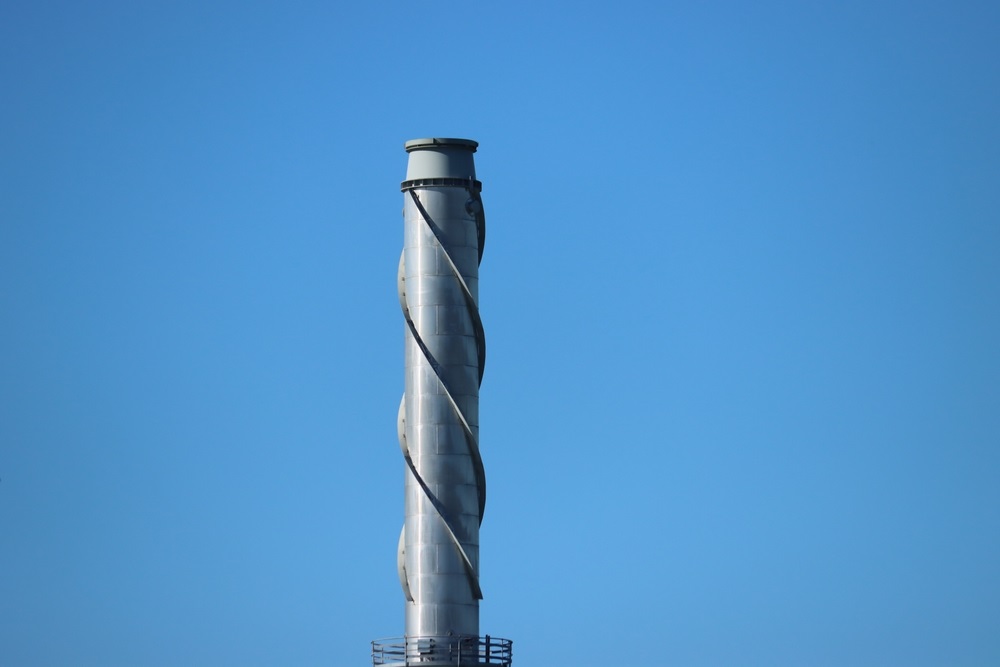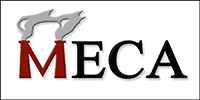
Wind-induced vibrations can cause serious problems for tall structures like stacks. Helical strakes are a proven solution to reduce these unwanted shakes. Our article will guide you through how MECA Enterprises uses helical strakes effectively to safeguard your projects against wind damage.
Read on to find out more!
Understanding Wind-Induced Vibrations
Wind-induced vibrations occur due to the shedding of vortices, causing structural oscillations. These vibrations can lead to fatigue failure and compromise the integrity of the structure.
Causes of vortex shedding
Vortex shedding occurs when wind moves past a solid object, such as a tower or stack, leading to alternating areas of low pressure on the side opposite the wind. This action forms spinning patterns in the fluid movement that break off and drift away from the object.
The process is closely related to several factors including the shape of the item in question, how fast the wind is blowing, and various aspects of its structure like vibration modes.
As these spinning vortexes shed at consistent intervals, they can make structures vibrate at their own natural frequency.
Knowing how vortex-induced vibration (VIV) works is essential for figuring out how buildings and other structures will stand up to wind forces. Important elements like Reynolds number, Strouhal number, and drag force play a big part in helping engineers predict how airflow can dynamically impact different constructions.
By using computational fluid dynamics (CFD) analysis to guide aerodynamic adjustments, it’s possible to greatly reduce or even stop dangerous vibrations resulting from vortex shedding altogether.
Consequences of stack failure
When stack failures occur, they kick off a chain of undesirable events, starting with structural damage. This harm doesn’t just affect the stack; it often damages surrounding structures due to debris falling or because of increased wind pressure being transferred.
Engineers are aware that facing such failures means more than just fixing things up. They have to dive into analyzing how structures react and shake to figure out what went wrong and how to make sure it doesn’t happen again in the future.
Furthermore, these failures can hit operational efficiency hard for facilities that depend on these stacks for ventilation or getting rid of exhaust gases. Not only do businesses face repair bills, but they also suffer significant downtime and loss of productivity.
In extreme cases, vibrations caused by the wind leading to a failure could lower safety standards, risking people’s lives and opening companies up to legal issues as well as tarnishing their reputation among customers and within fields that rely on structural engineering know-how.
MECA’s Software Solutions
MECA offers MecaStack, the world’s most widely used software for stack design, and helical strakes to mitigate wind-induced vibrations. Engineers can rely on MECA’s innovative solutions to prevent stack failure and improve performance while enjoying cost-effective options.
MecaStack for stack design
This innovative software has changed the game in stack design by offering an easy-to-use solution that tackles the complexities of structural dynamics and vortex-induced vibrations head-on.
Now, engineers and designers can carry out finite element analysis, dynamic response evaluations, and harmonic analysis with unprecedented ease. This powerful tool provides thorough wind loading assessments to ensure stacks are built strong enough to stand up against even the toughest weather conditions.
Professionals working in fields like business ownership, engineering, and commercial construction now have access to a robust platform that accurately models flow-induced vibration scenarios.
The software’s capabilities span from assessing deflections and stress tensors to determining aerodynamic modifications needed for optimizing stack design for both high performance and longevity.
By incorporating this software into their daily operations, users can significantly lower risks tied to wind-induced vibrations while also improving the lifespan of their structures.
Helical strakes for mitigating wind-induced vibrations
Mitigate wind-induced vibrations effectively with helical strakes. These specially designed structures disrupt and reduce vortex shedding, a common cause of wind-induced vibrations when installed on the exterior of stacks.
Strategically placing helical strakes along the stack helps minimize vibration, preventing potential stack failure due to excessive oscillations in windy conditions.
Furthermore, helical strakes offer a cost-effective approach to enhancing stack performance and lifespan. Incorporating these innovative solutions ensures improved structural integrity while reducing the risk of fatigue cracks caused by wind-induced vibrations.
Engineers and construction professionals can rely on expertise in providing practical solutions for addressing wind-induced vibrations in commercial construction projects.
Benefits of Using MECA’s Solutions
MECA’s solutions prevent stack failure, improve performance, and extend the lifespan of stacks. They provide cost-effective measures for mitigating wind-induced vibrations.
Prevention of stack failure
Preventing stack failure requires engineers to implement effective solutions for mitigating wind-induced vibrations. By using helical strakes and MecaStack software for stack design, the risks of vortex shedding can be significantly reduced.
These solutions lead to improved stack performance, increased lifespan, and lower maintenance costs.
Utilizing helical strakes disrupts the formation of vortices along the structure, reducing wind-induced vibrations. Additionally, MecaStack software enables precise design considering factors such as wind loads and structural integrity to mitigate risks associated with vortex shedding.
Improved stack performance and lifespan
Using MecaStack and helical strakes improves stack performance, reducing the risk of wind-induced vibration failure. This prolongs the stack lifespan and avoids costly repairs or replacements.
Implementing these solutions ensures efficient and reliable stack functionality, benefiting commercial constructions with long-term cost savings.
Integrating Meca’s software and damping solutions allows businesses to optimize their stack performance while minimizing the risk of damage due to wind-induced vibrations. These advancements provide a solid foundation for robust construction projects, ensuring structural integrity and durability over time.
Cost-effective solutions
Helical strakes offer a cost-effective way to reduce wind-induced vibrations. These solutions enhance the stability of structures, cutting down on expensive repairs and replacements.
By using advanced damping technology, businesses can save money on maintenance and operational costs.
Engineers can count on expert help to find affordable ways to address wind-induced vibrations in high-mast light poles and commercial buildings. Implementing these strategies ensures long-term performance and resilience against the damaging effects of vortex shedding.
MECA’s expertise and effectiveness in providing solutions for wind-induced vibrations
A pioneer in providing effective solutions for wind-induced vibrations in stacks, our company offers innovative damping solutions and widely used software to prevent stack failures.
Our software has been proven efficient in mitigating wind-induced vibrations, leading to improved stack performance and extended lifespan. We focus on delivering cost-effective solutions tailored to the needs of clients, setting us apart from competitors.
Engineers and commercial construction companies can rely on our expertise for designing stacks and implementing damping solutions such as helical strakes to effectively address wind-induced vibrations.
FAQs
1. What are helical strakes and why do we use them?
Helical strakes are spiral-shaped devices attached to structures like chimneys or towers to reduce wind-induced vibrations by disrupting airflow patterns. We use them to improve wind resistance and extend the structure’s fatigue life.
2. How do helical strakes work against wind?
When wind hits a structure, it can create vortex-shedding which leads to vibrations. Helical strakes break up these airflows, reducing lift forces and drag coefficient, which in turn suppresses vibration.
3. Can we test how effective helical strakes are before installing them on buildings?
Yes! Wind tunnel testing allows us to observe the crosswind response of a model equipped with helical strakes. This helps in understanding their effectiveness in vibration suppression under various conditions including turbulent flows.
4. Do engineers have tools to predict how well helical strakes will perform?
Engineers use numerical models and CFD (Computational Fluid Dynamics) simulation based on fluid–structure interaction principles, considering factors like viscous fluid flow, frequency domain analysis, shear layers, and thermodynamic temperature effects to predict performance accurately.
5. Are there other solutions besides helical strakes for mitigating wind-induced vibrations?
Indeed! While helical strakes are effective for many structures, tuned mass dampers (TMDs) can also be used as damping systems for controlling vibrations by dynamically responding to the building’s movement caused by wind loads.
6. Why is understanding wind behavior around buildings so important when deploying measures like helical strakes or TMDs?
Grasping the fundamentals of how wind interacts with structures – through studying phenomena like three-dimensional flow dynamics, conservation equation applications including mass conservation and energy conservation – enables more precise design choices that enhance safety measures against destructive resonant frequencies while optimizing structural designs’ overall efficiency against harsh environmental impacts.
